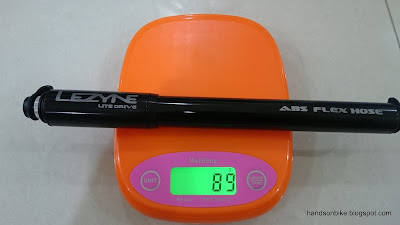I prefer to have the child seat in front of the rider, which means that all the bikes with drop bars are out. This means that the Java Freccia mini velo, Merida Scultura 5000 road bike and Avanti Inc 3 cannot be used. As for the Dahon MuEX or the Dahon Vitesse, only rear placement child seats can be installed on the seatpost, which will add on more weight to the rear of the bike and possibly make it easier to tip over backwards. Also, it will be good to put the child's weight at the front of the bike to balance out the rider's weight, instead of adding more weight to the rear of the bike.
Bobike child seat mounted on Brompton
Then, I came across the Bobike child seat mounted on the Brompton, and I knew that it was the one that I wanted. Problem is, I did not have a Brompton. I considered getting replica Bromptons such as the Cigna or the 3Sixty, but I was not too impressed with the folding which is still not good enough. Besides, I was reminded of the Flamingo bike that I had previously which was a Brompton replica, and it was just not good enough. Instead of having to fix problems here and there from getting a replica bike, I decided to get a real Brompton and also get a chance to study the real thing.
Initially, I had considered getting a 3 speed Brompton, but 6 speed Bromptons are more common. Besides, no harm having more speeds just in case I need to climb up slopes with extra weight from the child.
I also considered getting a second hand Brompton, but since I was totally unfamiliar with a Brompton, I am not sure what to look out for when getting a second hand Brompton. There are many proprietary parts on a Brompton, and replacements can be hard to find or are costly. Therefore, after checking out the bikes at the local distributor, I finally committed to getting a new Brompton M6R.
There was also a choice of getting the pre-2017 models, or the new 2017 models. For me, the main difference was the shifters, where I liked the 2017 shifters just a little bit better. However, the price difference was $500, which is a lot just for different shifters. Therefore I got the pre-2017 models which are less expensive.
Brompton M6R in Lagoon Blue on all frame parts!
Pre-2017 model, with older shifters
3 speed shifter for the Sturmey Archer hub. At least the brake levers are nice.
2 speed shifter for the 2 speed rear derailleur. Foam grips, not so nice.
2 speed shifter is integrated with a bell
Lagoon Blue handlepost for M bar
Front caliper brake with front reflector and front mudguards
16 inch 349 wheels, with 15mm nutted axles, and fitted with Brompton Kevlar tires
Cable routing to enable proper folding with just the right amount of cable slack
Handlepost and frame hinge clamps, with aluminium clamp plates and plastic levers
From the local distributor
Brompton saddle mounted on the unique Brompton saddle clamp that mounts the saddle forward for a compact fold
Stock elastomer suspension with a Firm rating instead of the softer Standard type
12% reduced gearing with 44T front chainring, on an old school square taper crankset
Rear drivetrain and shifting components. Looks rather haphazard with lots of exposed bits.
Indicator chain that controls the 3 speed hub, along with the 2 speed side swing rear derailleur and the chain tensioner
Rear caliper brake. Note that both caliper brakes have cables that route from below instead of from the top.
Rear rack with stock easy wheels for rolling the bike along when folded
Sturmey Archer 3 speed hub, special Brompton Wide Ratio version, paired with 16/13T sprockets for 6 speeds
In parking mode, with just the rear triangle folded under the frame
Square taper bottom bracket, looks like it can be removed with a standard bottom bracket tool
Zefal pump included with the Brompton bike and cradled in its unique mount
Close up look at the 2 speed side swing rear derailleur and the pulleys
Made in London
The chain tensioner takes up the chain slack when the rear triangle is folded to prevent chain drop
Brompton fully folded. Very compact!
About 2cm of clearance between the foam grip and the ground when folded
Weighs 12.3 kg stock, including the Zefal pump
This bike will be mainly used to carry the child when I cycle, so that everyone can ride together. Cutting weight from this bike is not necessary as there is not much point. Reason being that this bike has a heavy steel frame, and so any weight savings from components will be quite insignificant. From my experience, reducing the bike weight from 12 kg to 10 kg does not make a big difference, as it is still relatively heavy. Also, putting a child of 10+ kg onto the bike will negate any weight loss. Lastly, there is no need to carry the bike when folded, as I can roll it along most of the time.
I have already identified a few areas on the bike that can and should be improved, and these upgrades will be made soon. These upgrades will not make the bike any lighter or ride any faster, but are mostly cosmetic and functional upgrades.

































































